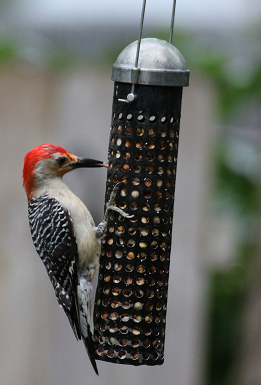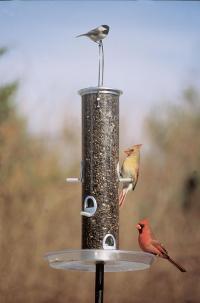Newsletters
Winter Bird Feeding

Have you ever wondered why when winter comes to Nebraska some birds migrate to warmer climates, many as far south as the tropical forests of South America? Yet other birds choose to remain in the Central Great Plains where the days are short and the nights are long and bitterly cold? Why do some birds such as Dark-eyed Juncos, Pine Sisikin, and Redpolls come to Nebraska from their far snowier northern ranges to spend the winter? Do some birds have warmer feathers, more feathers, or are they just confused?
Consider this. If you are a bird which only eats insects will you survive a Nebraska winter? How many insects will you find as temperatures drop and the snow piles up? None! You better move south where insects will be plentiful. However if you’re a bird that eats seeds, berries, and nuts, there is plenty of food available during winter in the natural habitats across Nebraska. This may include your backyard if you plant habitat to provide food, water, and shelter for birds. So the fall migration of birds is primarily based on what the food availability will be during the coming winter.
But throughout winter natural foods for those birds remaining behind become buried by snow or destroyed by weather. This increases the competition among wildlife for declining natural food sources and requires more time spent foraging.
So what can you do to help the birds get through the cold winter months in Nebraska? After all, birds only survive the cold nights from the energy provided by the food they consume during the day. So what can you do? Provide extra food for our birds in a backyard bird feeder.
Feeding birds can be as easy as throwing a handful of wild bird feed on the ground. But various bird species have different feeding habits. With bird feeders you can help a larger variety of birds and enjoy watching them in your backyard as they feed.
A platform feeder on the ground will attract ground feeding birds such as Mourning Doves, Juncos and native sparrows. White Proso millet and safflower seed work best on ground feeders. These wild bird feeds are the least attractive to squirrels who, given the opportunity, enjoy robbing feed from backyard bird feeders.
The bird everyone enjoys viewing in a winter landscape is the bright red male Northern Cardinal. Cardinals, along with Blue Jays, are opportunistic birds that feed at a variety of bird feeders if there is a large perching area to sit and feed. Hanging platform bird feeders stocked with sunflower seeds, peanuts, and safflower seed work well for these larger birds. 
A hanging seed tube bird feeder, those having several large open ports with perches, are attractive to smaller birds like Black-capped Chickadees, nuthatches, and finches. These feeders are ideal for feeding black oil sunflower seed and hulled sunflower seeds. Sunflower seeds are high in protein providing an excellent source of energy for birds to keep warm during cold nights.
Nyjer thistle seed feeders are tube type bird feeders with small slits where Goldfinches, House Finches, and Pine Siskin can extract the tiny thistle seeds. Nyjer thistle seed is also high in protein and provides a great source of energy to keep these little finches warm and full of energy.
For woodpeckers and other birds that forage on the trunks and branches of trees suet provides a source of high energy animal protein. Suet is rendered animal fat which is sold in cakes for feeding birds. The meat department at your local grocery store may offer raw animal fat and beef suet to feed birds at little or no cost. Lard can also be used to create your own suet recipe by mixing in peanuts, fruits pieces and other wild bird feeds.
And don’t forget to provide fresh water for birds during the winter since most natural water resources are frozen solid. Water is essential for the survival of all living creatures. Fresh water also allows birds to bathe. Clean feathers provide better insulation to stay warm during cold winter nights. You can use a bird bath heater to keep the water from freezing, or supply fresh water in a pan daily. Birds will get use to the timing of that available water source and come for a drink before it freezes over.
Bird feeders can be purchased or made at home from a variety of recycled materials. Providing supplemental food for birds in your backyard during the winter months, or year round, is beneficial for the birds and a great way to enjoy nature right in your own backyard.
